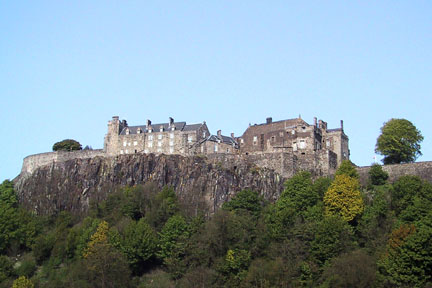
Mary, Queen of Scots Home Page

The earliest recorded castle at Stirling was used by Malcolm Canmore in the 11th century. Alexander I died here in 1124, as did William the Lyon in 1214. Edward I of England captured the castle in 1304 when he used a siege engine called the "War Wolf", even though the garrison had already surrendered. William Wallace took the castle for the Scots, but it was retaken by the English until the Battle of Bannockburn in 1314. Robert the Bruce had the castle slighted, but it was rebuilt by Edward III of England, after his victory of Halidon Hill in 1333, in support of Edward Balliol. The English garrison was besieged in 1337 by Andrew Moray, but it was not until 1342 that the Scots recovered the castle. James III was born here in 1451. James II lured the 8th Earl of Douglas to it in 1452, murdered him, and had his body tossed out of one of the windows, despite promising safe conduct.
Click here to see a reconstruction of the castle.
The present castle which dates only from the 15th century, stands on a sheer 250-ft crag. The castle's Parliament Hall was built for James III, and his son James IV added the fine gatehouse. James V built most of the royal palace in the early 16th century, and turned the castle into one of the most sumptuous in Scotland. James VI, Mary's son, remodelled the Chapel Royal (below) for the christening of Prince Henry in 1594.
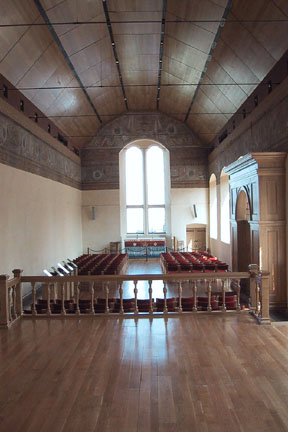 |
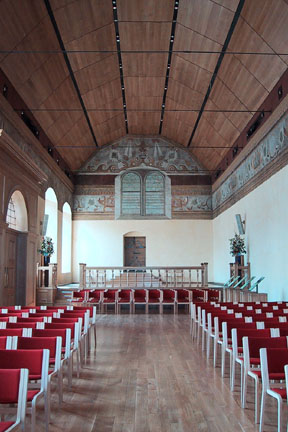 |
Mary spent the first few years of her life, from 27 July 1543 within the safe confines of this castle and in the hands of her guardian Lord Erskine, to February 1548, when she was moved to Dumbarton Castle and eventually shipped to France. It is here, in the Old Chapel, that Mary was crowned Queen of Scots on 9th September 1543 aged only 9 months. The ceremony was by no means lavish, and consisted of the quick investiture of the child in the presence of the nobility. The Earl of Arran bore the crown, the Earl of Lennox the sceptre, and the Earl of Argyll the sword of state. The pro-English party, including Angus, Gray, Glencairn, Cassillis and Maxwell, stayed away altogether. Sir Ralph Sadler reported scathingly back that Mary had been crowned "with such solemnitie as they do use in this country, which is not very costlie". Even the date chosen was full of ill omens, falling on the thirtieth anniversary of the Battle of Flodden.
Stirling Castle being a crown palace, Mary spent quite some time there. A month in summer 1562 and most of September, October and November the following year, April and May of 1565, and some days in September and December of 1566 when her son was lodged there in the care of John Erskine, Earl of Mar and son of Mary's own former guardian. On 17th December 1566, she attended little James' christening, who was brought to the Chapel Royal in the arms of the Count of Brienne, proxy for the King of France, in a torchlight procession. The godparents were Elizabeth I of England, who notoriously absent, sent a gold font and was represented by Jean, Countess of Argyll and also the child's aunt, Charles IX of France, Mary's brother-in-law, and her uncle, the Duke of Savoy represented by M. du Croc. James was christened according to catholic rites but Mary refused to let the priest spit in the child's mouth as was the custom. The ceremony was attended by many of the Scottish nobles, but the Protestant Lords together with Bedford, Elizabeth's emissary, stayed outside the chapel. Mary spared no expense for this ceremony, clothing the nobility and ordering masques and fire-works. Darnley, the child's father, who had put the final nail in the coffin of his disastrous marriage to Mary by aiding and abetting the murder of Riccio, and had also fallen from grace with Elizabeth and the French court, kept a low profile sulking in a corner of the castle. Indeed, it would not be long before he met his own untimely death at Kirk o'Field.
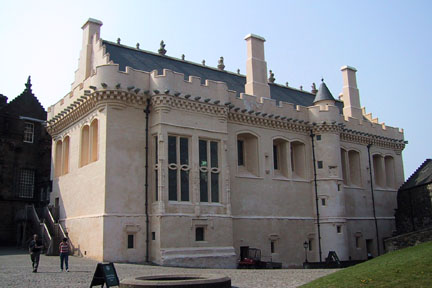 |
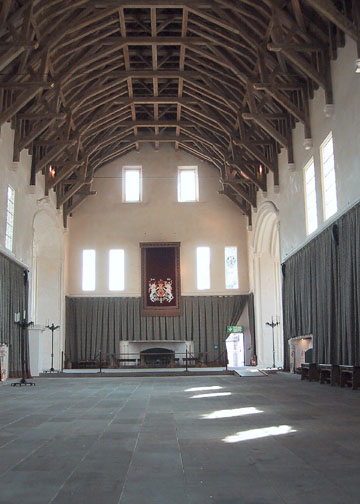 |
One of the main features of Stirling Castle is the recently fully renovated Great Hall with its stunning hammerbeam ceiling, modelled on the ceiling of the Great Hall of Edinburgh Castle, and does not contain a single nail. Its limestone exterior might seem surprising at first as it contrasts with the dark colouring of the rest of the castle, but it is in fact how the building would have looked in earlier times. The King and the Queen's bedchambers located in the Royal Palace (below) are also in the process of being restored to their original splendour.
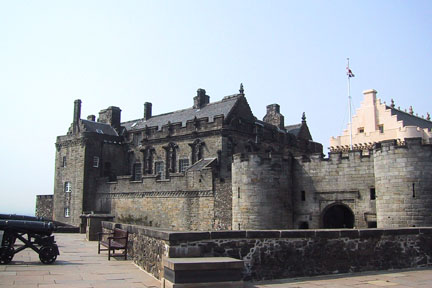 |
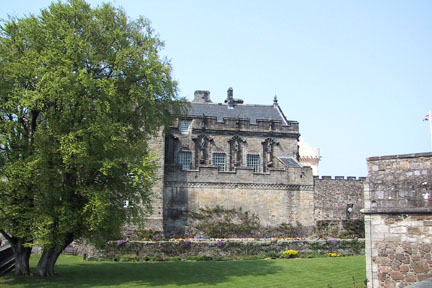 |
The King's Knot, the great formal garden behind the south fašade of the Palace, is thought to date to the time of Mary's grandson, Charles I, but her father, James V, employed a French gardener at Stirling in the 1530s and thus the establishment of a garden here may date to these years. Mary's first visit to Stirling Castle since her return to Scotland, was on 13 September 1561. The next day, she was subjected to an incident during which her priests and clerks were beaten up by Lords Argyll and James while the High Mass was being sung in the Chapel Royal. This came as a shock to Mary as, not long before that, Lord James had stopped the mob from disturbing Mary's private mass at Holyrood. Later that evening, Mary came very close to asphyxiation when she left a candle burning by her bedside, which set fire to the curtains of her four-poster bed.
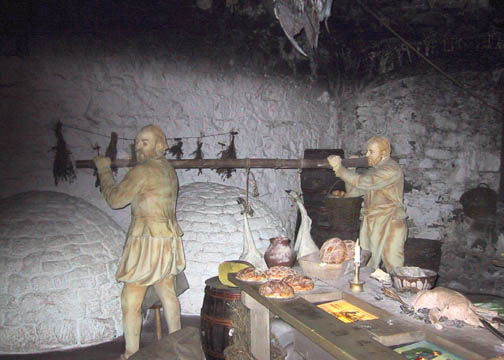 |
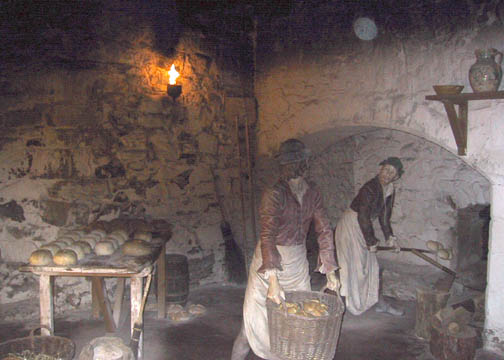 |
Open all year. Tel.: 44+ (0)1786 450 000